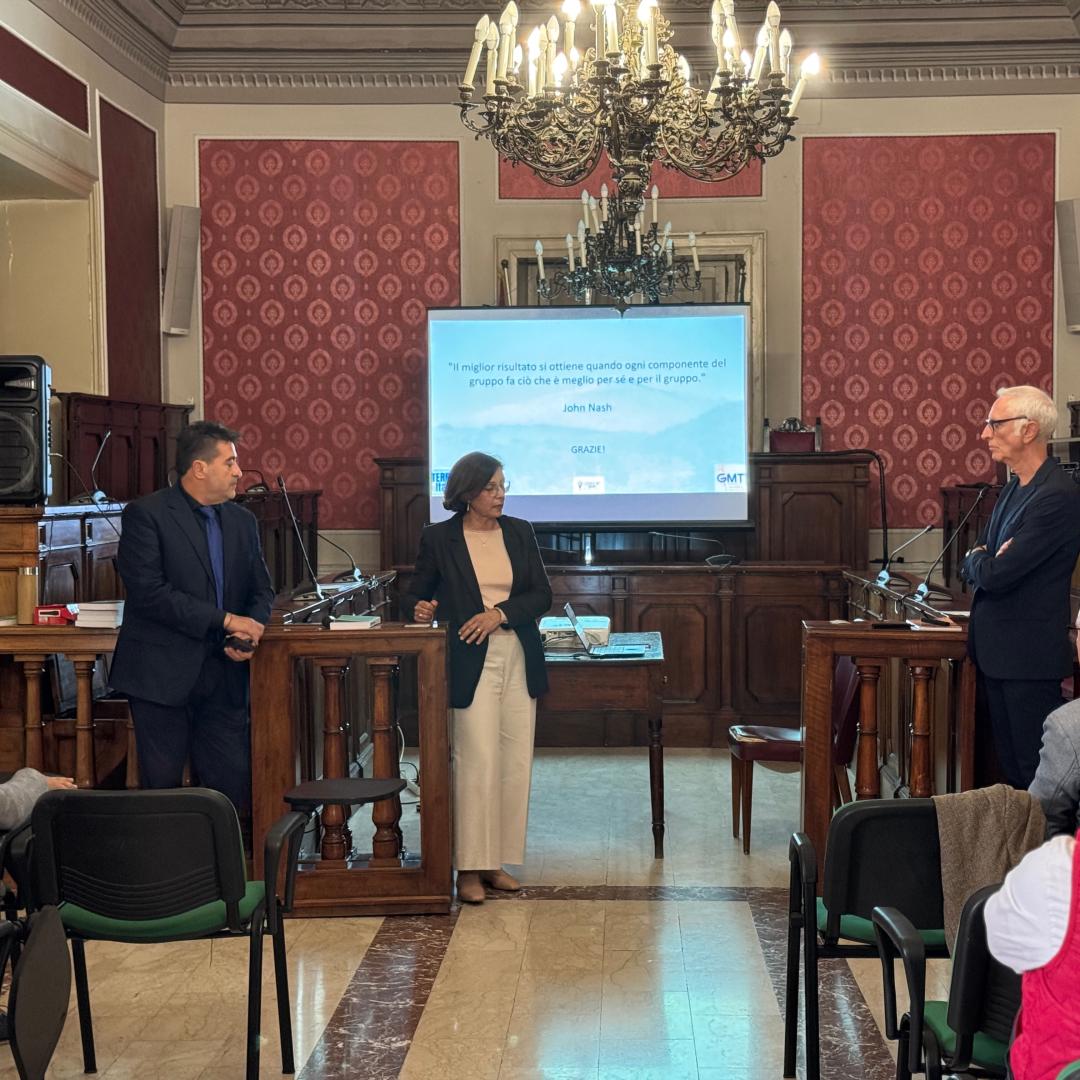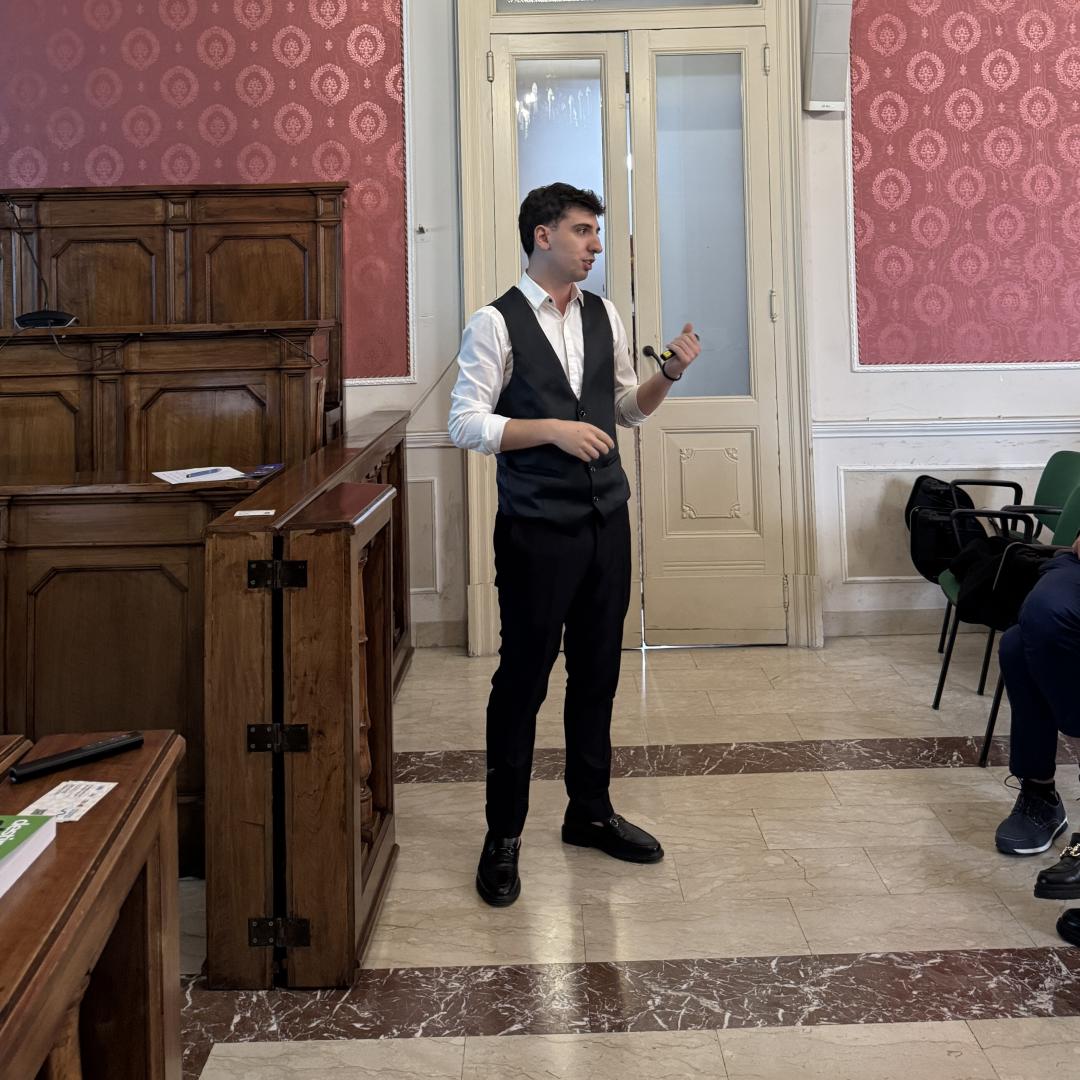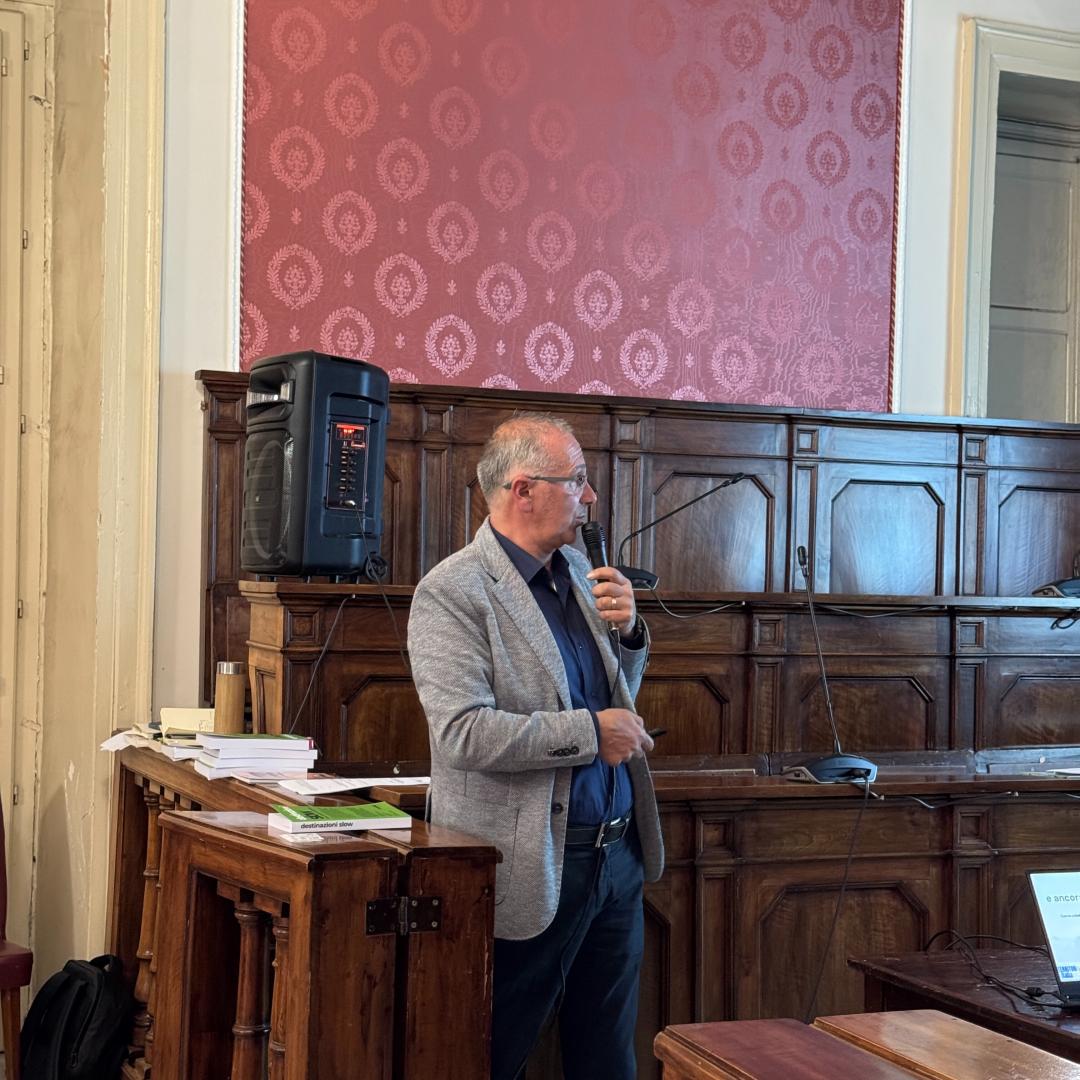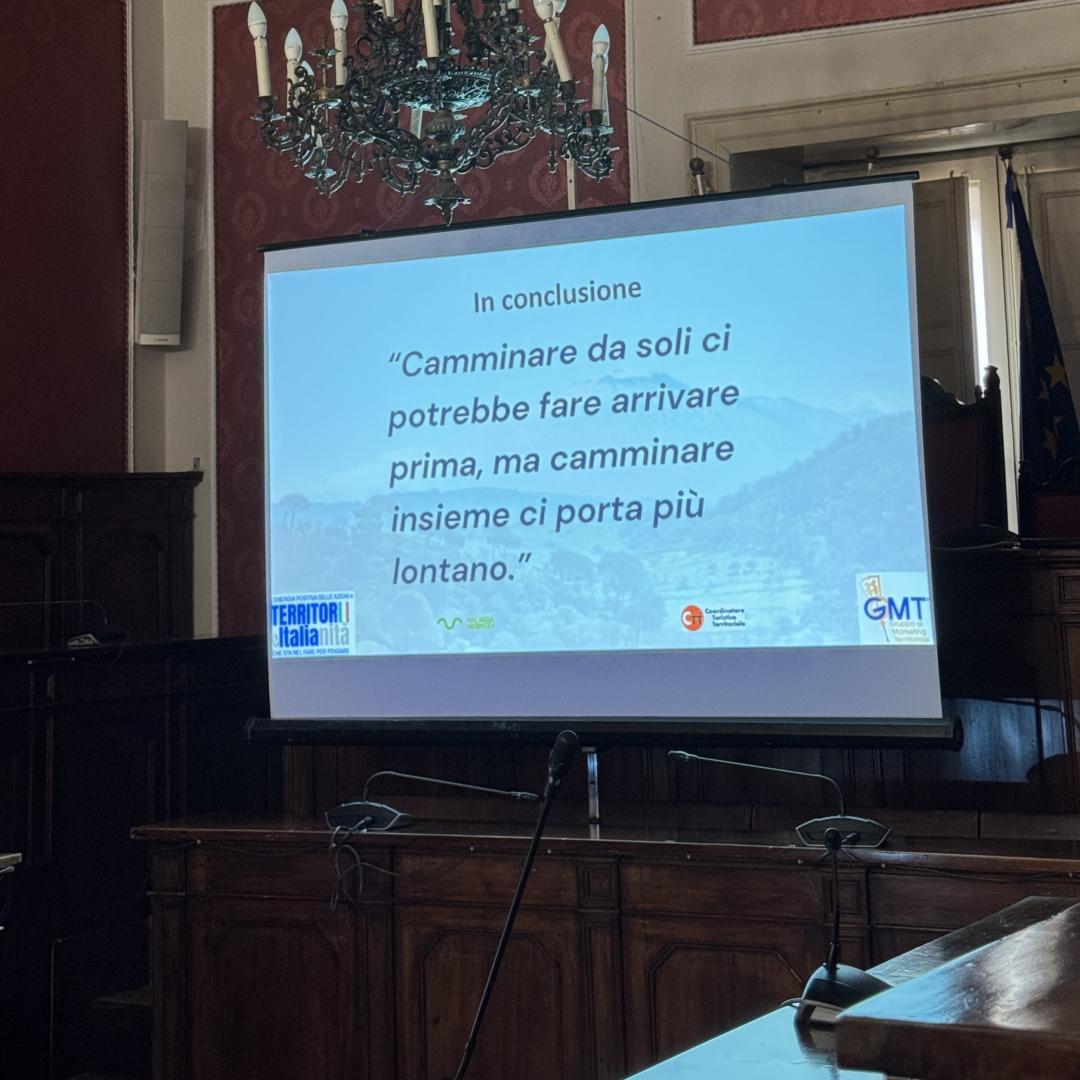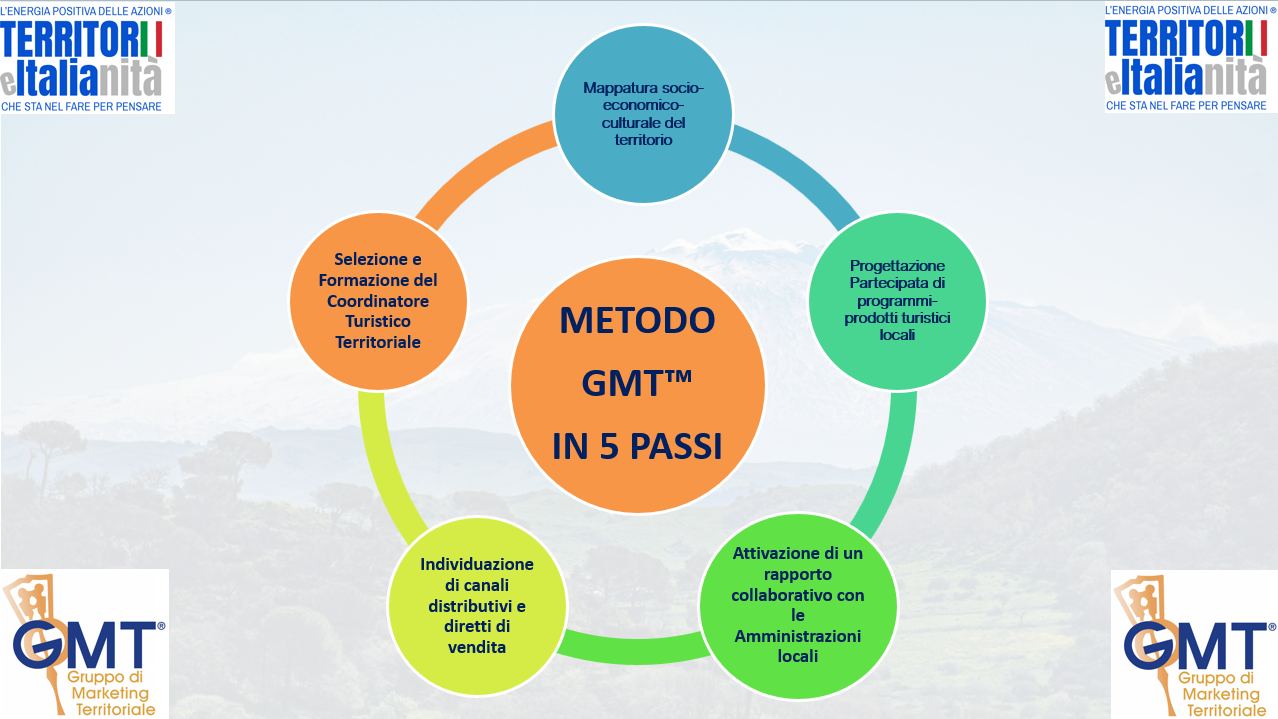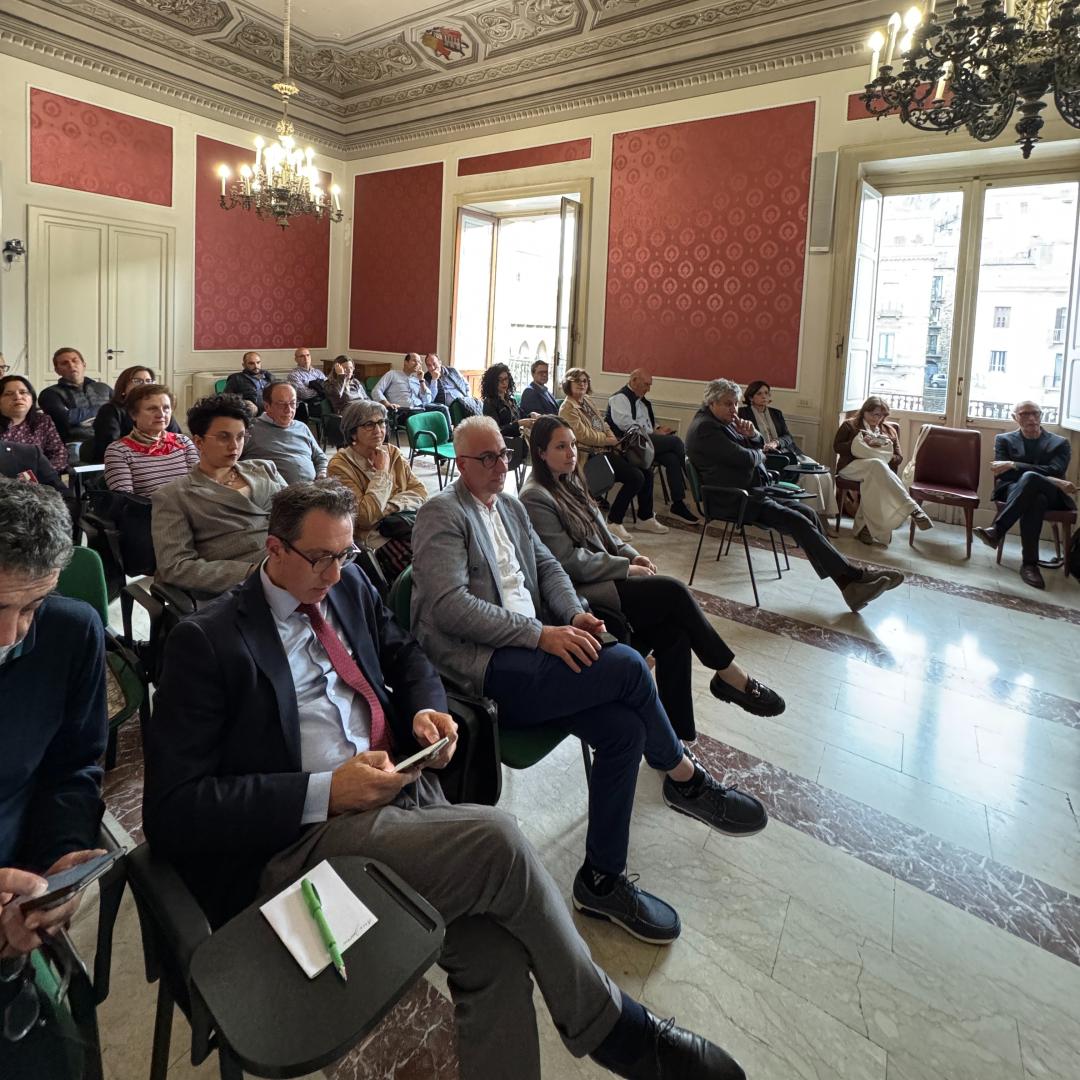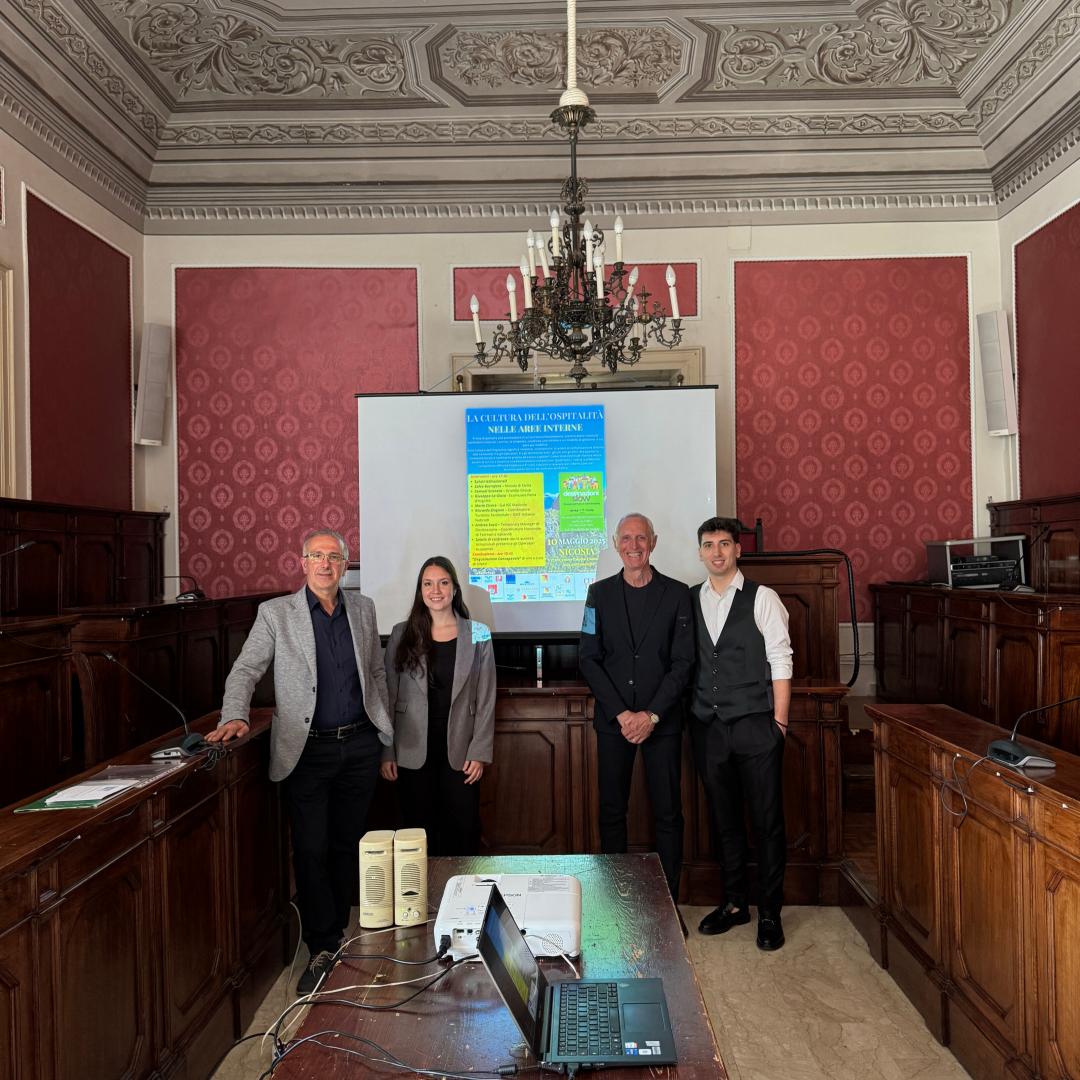Workshop on Inner Areas in Nicosia - Sicily
The culture of hospitality as the foundation of the tourism offer in inner areas
Halaesa Nebrodi 11/05/2025 0
The city of Nicosia hosted the second Sicilian stop of the Grand Tour of Territories and Italian Identity (and eleventh nationally), after the one held in Mistretta on January 26, 2024, through a workshop dedicated to the Culture of Hospitality in Inner Areas.
The event, organized by Andrea Succi (Territori e Italianità), Salvo Burrafato (Nicosia di Sicilia), Samuel Granata and Valentina Bircher (Grandip Group), and Riccardo Zingone (GMT™ Halaesa Nebrodi), was sponsored by the Municipality of Nicosia, the Department of Tourism and the Department of Agriculture of the Region of Sicily, GAL ISC Madonie, ANCI and SIMTUR.
Partners of the Nicosia event included Royal Guest, Aura Mundi, Espereal Technologies, and Maggioli Cultura as media partner.
Following the institutional greetings from Nicosia’s Mayor Luigi Bonelli, and in line with the spirit of the initiative, the event quickly moved into its core discussions with contributions from Salvo Burrafato, Andrea Succi, Riccardo Zingone, Pina La Giusa, and Samuel Granata. The organizing team deliberately used the term workshop to give the meeting a clearly pragmatic and operational angle by presenting the first results of the GMT® Model applied in the nearby Halaesa Nebrodi area,addressing the needs expressed by administrators, operators, and citizens aware that, to build regenerative prospects for inner areas, dedicated models and skills capable of offering real solutions to devastating phenomena such as depopulation and loss of identity are essential.
Andrea Succi described the methodological framework applied to the regeneration of inner areas, starting from the need to adopt a Vision, at the heart of Territori e Italianità through the format of the "Five Steps".
Emerging themes included the participatory approach needed to generate structured internal communication among operators, citizens, and administrators, the conscious knowledge of one’s own identity elements (genius loci) and the transfer of skills, for a renewed work culture, an essential condition to address depopulation.
Based on these principles, good practices must be generated, fueled by mayors aware of their role, motivated and properly trained operators, and engaged and participatory citizens in a forward-looking process where the Destination Temporary Manager and the Territorial Tourism Coordinator™ play a crucial role—the former to effectively organize the tourist destination, the latter to ensure the long-term sustainability of the work initiated.
Salvo Burrafato, who skillfully coordinated the event, also illustrated to the audience the first experiential tourism route proposed by Nicosia di Sicilia, with stays ranging from three to seven nights, offering a deeply immersive experience in the world of rural life, food and wine traditions, and culture. This tourist package was also included among the products in the Halaesa Nebrodi catalog titled The Grain Route , expanding and enriching it with further significant experiences.
Through the words of Riccardo Zingone, the GMT™ Halaesa Nebrodi was presented to the community as a concrete example of territorial tourism work and organization.
The project, launched in 2024, began with a meticulous operator scouting activity and marked several key steps such as the launch of the website www.halaesanebrodi.it, followed by the creation of a first Tourism Product Catalog, thus setting the conditions to fully enter the national and international tourism market, effectively positioning this area as an authentic tourist destination.
The very notion of a “model” implies its replicability, and it is hoped that the GMT™ Halaesa Nebrodi model—first of its kind in Sicily—can be adopted by other inner areas and communities that need practical tools to counteract the social and economic decline they have been facing for decades.
Also very meaningful was the contribution by Mario Cicero, mayor of Castelbuono and President of GAL ISC Madonie, who shared with the audience his twenty-year experience as administrator of the Madonie village, and welcomed the opportunity presented by Territori e Italianità to develop tourism projects in synergy with GAL ISC Madonie. Equally valuable was the testimony of Samuel Granata, a young Nicosian who chose to remain in his homeland, bravely investing his energy in the tourism sector, along with that of Pina La Giusa, entrepreneur and President of the Petra D’Asgotto Ecomuseum, who focused her speech on the projects carried out by the Ecomuseum, including the archaeological excavation project on Mount Altesina, which led to new and interesting discoveries in March through a second agreement with the University of Paris and the involved local authorities.
The lively and educational debate was joined by Giacomo Consentino, owner of the 24 Baroni craft brewery, Maria Scavuzzo from the Albereto dairy, Francesco Dipasquale of Espereal Technologies, Antonino Noto, President of the Pro Loco of Motta d’Affermo, Fabio Bruno, President of the Movement for the Defense of Territories, Giuseppe Lo Furno of the Italian Farmers Federation, Anna Maria Gemellaro, deputy mayor of Nicosia, and Giacomo Giaimi, geologist and hiking guide. In particular, Anna Maria Gemellaro, deputy mayor of Nicosia, proposed the inclusion of the GMT Model and the innovative figure of the Territorial Tourism Coordinator® in the call for experiential tourism projects that the Municipality intends to apply for.
The event concluded with a pleasant and mindful wine tasting accompanied by local products, curated by ONAV.
You may also like...
Riccardo Zingone 12/08/2024
Mistretta - Inauguration of the "Noi" Wooden Sculpture sicily
The echoes of the inauguration of The Sea Road mural in Torremuzza have barely faded, and the Halaesa-Nebrodi territory is already enriched by another important and evocative work of art: "Noi: Inizio di una nuova vita" (Us: Beginning of a New Life), by Antonino Lipari, known to all of us as Nino.
We are in Mistretta, within the majestic municipal park named after Giuseppe Garibaldi, and the artwork stands where, until recently, a magnificent Norway Spruce (Picea abies) once proudly stood. The cycle of life accustoms us to its fluctuating rhythm, where life precedes death, and death — sometimes — generates life. And so, after several centuries of silent and undisturbed existence, the fir tree became irreversibly diseased to the point that, to safeguard public safety, the city authorities decreed its removal about a year ago.
The community began to wonder how to fill the large void left by the impending demise of the majestic tree. While initiatives were being considered, the administrators decided to completely trim its crown, which was by then irreparably diseased, and to preserve the vast majority of its trunk, which was healthy enough to envision reusing the resulting timber.
An Unexpected Gift
Then, at a certain point, a young carpenter from Mistretta, Nino Lipari, knocked on the mayor's door. With his characteristic politeness, he suggested carving an artwork, a sculpture, from the remaining trunk: "I'll take care of everything," Nino said, "and I don't want to be paid."
It must be said that Nino is not new to the art of wood carving; in the past, through private commissions, he had already demonstrated artistic skills that transcend those of a simple, albeit very skilled, artisan. But now things became decidedly more serious, and he would have to put himself out there, exposing his work to public judgment. Yet Nino was confident; he knew what he was doing, had clear ideas, and possessed the skills to realize them. Thus, he immediately gained the mayor's trust, and work began just a few months after the tree's removal.
Access to the left avenue leading to the central square of the park was closed, opaque nets were put up, and simultaneously, the curiosity of passersby grew. They could barely glimpse scaffolding, the outline of the fir trunk, and Nino moving around it, but nothing more. The work lasted several months, and finally, on the evening of August 11th, the artwork was inaugurated, coinciding with the restoration of the lighting of the main gate of the municipal park.
"Noi": A Symbol of Love and Renewal
Noi blossomed at dusk on a pleasant August evening, contrasting with the sad days of the cutting of the majestic mother-plant that had held it in its womb for three centuries. In this journey that intertwines life with death, and allows death to generate life, Nino sensed the presence, in that trunk otherwise destined for the sadness of abandonment, oblivion, if not destruction, of an opportunity for rebirth and regeneration that could take shape through his hands, his tools, and his heart.
Nino then chose to embark on a reinterpretation of José Luis Santes's The Embrace and thus decided to celebrate his love for his land through the tender and eternal embrace between two lovers. It is a message so simple in its genuineness that, at times, we don't fully grasp its power. But Nino, with his artwork that he decided to give to the community, reminds us that giving oneself to others is also a form of love, that solidarity among people is an act of love, as is gratitude, and that one can become a father infinitely, just as he himself demonstrated by transforming a raw and shapeless piece of wood into a magnificent work of art that all of us can enjoy and through which we will have opportunities to reflect on the true meaning of life.
With these brief words, we extend a warm virtual hug to Nino, his family, and his collaborators, along with a sincere thank you for the significant gesture he performed.
Learn about the Operators and the Project of GMT Halaesa-Nebrodi.
Halaesa Nebrodi 09/11/2024
People of Halaesa-Nebrodi: Filippo Fratantoni Sicily
Stepping across the threshold of the large building housing the Ceramiche Fratantoni showroom and factory means immediately immersing yourself in a world whose contours are clearly defined by the gray of the clay ('a rita in the local dialect) of countless vases, "Moro heads," and lamps, all crafted and left to rest, awaiting glazing and firing. This stark contrast is met by the explosion of vibrant colors used for decorating the finished artifacts that literally fill the exhibition spaces. At the center of the stage of a nearly century-long performance, a workbench stands out, surrounded by pieces already worked but awaiting decoration and firing. It's a magnificent scenographic and communicative choice that speaks volumes about this ancient expressive art, which only finds its final expression at the end of a long working cycle.
Within this complex and ancient world are the people, the artisans, and the skilled workers who have dedicated themselves to this magnificent art for centuries and who have made Santo Stefano di Camastra famous worldwide: the ceramists, or, to use a lesser-known term, the ceramicari.
Filippo Fratantoni is one of them, son of ceramists and a ceramist himself. He's a multifaceted individual, always involved in the social life of his Santo Stefano di Camastra, to which he also dedicated a long political period.
The Legacy of Ceramiche Fratantoni
Filippo, this chat is taking place within one of the historic businesses of Santo Stefano di Camastra: Ceramiche Fratantoni, a descendant of the Ditta Fratelli Fratantoni, founded way back in 1935. What has happened in these 89 years of activity?
"The business was born in the post-war period when my grandfather and his four sons set up an artisan workshop where they produced 'i marazzetri and 'i cusuzze, which were nothing more than toys inspired by everyday objects. Using four lathes for processing, they created small bummuli, quartare, lemmi, and rasticetri, reproducing in miniature what Stefanesi artisans had long been producing in their workshops. The small pieces made were bought by street vendors who, aboard their carts, would then sell them in local markets for a few pennies, allowing less affluent children to also have a modest toy to play with.
Subsequently, at the end of the Second World War, a qualitative leap occurred, and the Fratantoni family, thanks to the purchase of larger warehouses and premises, dedicated itself to the production of terracotta for daily and building use, still remaining outside of ceramic products as we see them today.
In reality, at that time, furnaces and workshops were still located outside the town, along the national road (SS.113) that led towards Messina, which carried all the modest vehicle traffic of the era. These were the hard 1950s after the war, but subsequently, thanks to the economic recovery, we began to see Fiat 1100s, then Fiat 600s, some regular buses, and even tourists who, attracted by the goods left to dry by the numerous roadside artisans, began to be interested in purchasing the displayed products. From this moment on, interest also grew in producing and selling decorated ceramics, which led to the birth of 'a scola ceramica, now the Art School, which began to train the first decorators to support the master potters—a crucial moment given that the workers of the time did not have the skills to color their artifacts.
Our interest has always been directed towards reproducing 19th-century Stefanesi traditional tiles and bricks, and in the 1970s, we patented the glazing of lava stone slabs, with which we began to build tables of various shapes and sizes that would otherwise be impossible to create with clay, a material severely penalized in terms of resistance and contraction during firing.
Today, our company has reached the fourth generation. My brothers and I dedicate ourselves to the production of the classical line, particularly the production of tiles, while we give the younger generation the freedom to experiment with the new worlds and creative spaces offered by modern ceramics."
Responding to Market Challenges and Innovation
Some years ago, we witnessed an invasion of foreign-made products, especially from China, which had nothing to do with artisanal ones, distracting consumers and creating great confusion. How did the community of Stefanesi ceramists respond to this intrusive presence, what countermeasures were taken, and what has changed in the relationship with the end-user?
"We simply continued to do our job and to do it well. The real invasion happened, but it has also passed. Today, mainly reproductions of pinecones and 'Moro heads' arrive from China, which have little impact on our work. My father always told us: 'Don't get discouraged, ceramics always have their ups and downs,' and I must say that's how it has been. Today we are in a period of great recovery. People's taste is becoming more refined and they can recognize an object by the quality it expresses. The new generations are increasingly attracted to our world, thanks also to the presence of media and social media, which have given new impetus to our sector. Just think of the international projection that designers Dolce and Gabbana gave to the 'Moro head' by featuring it in some of their advertisements. This highlighted an object that has always existed but, undoubtedly, thanks to their intervention, has become highly sought after."
The MUDIS: A Diffused Museum
Filippo Fratantoni's name is closely linked to MUDIS, an acronym for "Museo Diffuso Stefanese" (Stefanesi Diffused Museum), of which you are the Artistic Director. I'm curious about the use of the term "diffused" and, at the same time, I'd like to delve into its history, which begins with Giuseppe Lanza Barresi, Duke of Camastra.
"We have always believed that Santo Stefano di Camastra is an open-air museum. The MUDIS was born from a vision that originated in the 1980s, thanks to the late mayor Gigi Famularo, who worked to find the necessary funds for the restoration of the palace that belonged to the Duke of Camastra. That's where the Museum of Ceramics was born, with ample exhibition spaces dedicated to the history of Stefanesi and Sicilian ceramics, coexisting with a very important collection of modern artistic ceramics. Alongside this, as part of the diffused museum project, there are installations scattered throughout the city, and our artisans' workshops themselves are an integral part, through their shops and colorful exhibition spaces that overlook the main streets of Santo Stefano in a very scenic way."
The "Passport of the Ceramic Route"
Artistic ceramics are a very important tourism driver, especially if the right synergies are created with other regional and national realities. I find the "Passport of the Ceramic Route" initiative very interesting. It aims to unite six Sicilian communities in a stimulating journey to discover the world of ceramics, and Santo Stefano is an integral part of it. The Passport was presented on March 24th of this year—I was there—but I didn't see many ceramists present. How many businesses have joined the project, and what developments do you foresee from this initiative?
"It's true. Although we ceramists have cordial and collaborative relationships with each other, we are quite reluctant to leave our workshops and engage in collective, broad-ranging projects. Sometimes in the past, the expected results were not seen, and this has led us to increasingly retreat into our individual activities, avoiding professional confrontation with other colleagues, and thus we have gradually given up on creating the right synergies. I think instead we should change our attitude.
Regarding the Passport of the Ceramic Route, I believe it was and remains a valid initiative that the current administration believes in and has put a lot of energy into. It probably needs to be revised in some aspects, but the initiative is truly interesting."
Ceramics in the Age of Robotics
The challenges of the third millennium bring us closer and closer to a robotic and computerized world. Do you think the world of ceramics and craftsmanship in general, sooner or later, will have to adapt to this non-gentle revolution? Will a robot ever use a stick to shape a "Moro head" or a brush to glaze a "Matrangela"?
"In reality, 3D printers have already entered the world of industrial ceramics. With them, and thanks to them, it's now possible to create decorated laminate slabs of 3 square meters with thicknesses of just a few millimeters, which would be impossible to achieve with traditional machinery. But we're talking about industrial and large-scale productions.
Craftsmanship is another thing: it's a place where 'a rita (clay), creativity, heart, and manual skill intersect. I don't believe a robot could ever intervene and replace the artisan-artist, at least in this aspect."
A Dream for the Future
Finally, Filippo, your story tells of a person who has dedicated himself to his company, his family, and his community. Do you have a dream tucked away that you would like to entrust to future generations?
"The dream exists, and I've kept it tucked away for several years: I would like to see a great museum of contemporary ceramics realized, with young artists from all over the world gathering in Santo Stefano to dream, experiment, and create contemporary works of art. It would be a valuable tool for cultural and tourist attraction to accompany the artworks contained in the Diffused Museum of Fiumara d'Arte, which would further strengthen the tourist and artistic vocation of our territory.
You can learn more about the Operators and the Project of GMT™ Halaesa-Nebrodi.
Halaesa Nebrodi 09/07/2025
Summer events calendar in the municipalities of Halaesa Nebrodi
If you're looking for a place where history, culture, and entertainment blend harmoniously, Halaesa Nebrodi is your next ideal destination. We're thrilled to invite you to immerse yourself in a unique experience, rich in events that will capture your every interest.
A Calendar Full of Emotions
Get ready to live unforgettable moments with a packed calendar of events designed for every taste:
-
Music: Let yourself be carried away by the melodies that will resonate through our streets, with concerts ranging from the most traditional genres to more contemporary notes.
-
Folk Traditions: Discover the most authentic soul of Sicily by participating in our traditional celebrations, where ancient costumes, dances, and flavors come alive.
-
Cabaret: Treat yourself to evenings of good humor with cabaret shows that will bring more than a few smiles to your face.
-
Art: Explore exhibitions and installations that highlight local and international talent, immersing yourself in the beauty that surrounds us.
-
Sports: If you love physical activity, you'll find sports events for every level, from nature walks to more challenging competitions.
-
Theatrical Performances: Experience the magic of outdoor theater, with performances that will enchant you and make you reflect.
And that's not all! You can also look forward to tastings of local products, artisan workshops, and many other surprises.
Halaesa Nebrodi Awaits You!
Every corner of Halaesa Nebrodi holds a story, an emotion, an attraction ready to be discovered. Don't miss the chance to experience an authentic, fun, and culturally stimulating vacation. Whether you're an art enthusiast, a music lover, a connoisseur of traditions, or simply looking for pure relaxation and entertainment, you'll find what you're looking for.
Come and visit us in Halaesa Nebrodi and enjoy its countless attractions! We look forward to making your vacation an unforgettable one.
